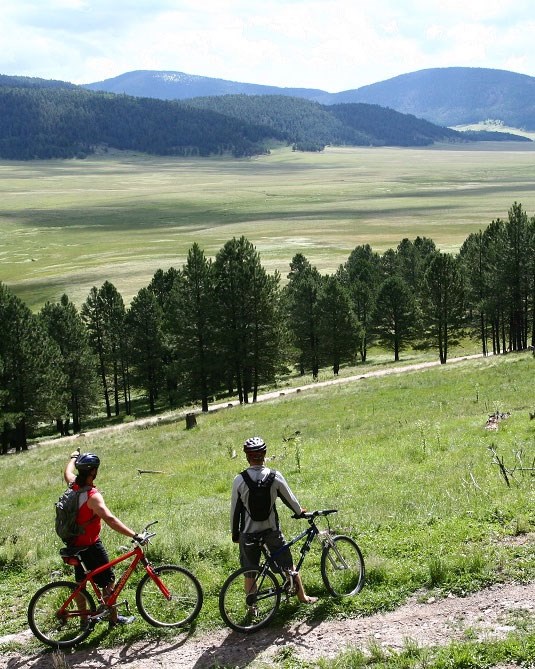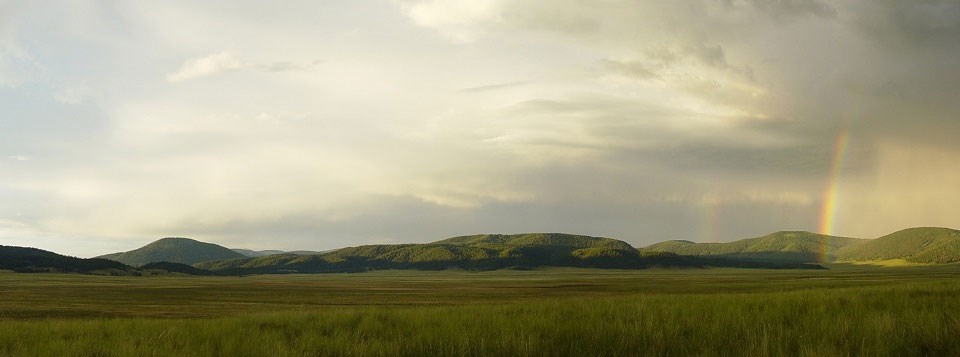Last updated: July 17, 2024
Article
NPS Geodiversity Atlas—Valles Caldera National Preserve, New Mexico
Geodiversity refers to the full variety of natural geologic (rocks, minerals, sediments, fossils, landforms, and physical processes) and soil resources and processes that occur in the park. A product of the Geologic Resources Inventory, the NPS Geodiversity Atlas delivers information in support of education, Geoconservation, and integrated management of living (biotic) and non-living (abiotic) components of the ecosystem.

Introduction
Valles Caldera National Preserve is located in the Jemez Mountains in Rio Arriba and Sandoval Counties, northern New Mexico. The national preserve was established on July 25, 2000 and added to the National Park System on December 14, 2014. Valles Caldera National Preserve contains 36,017 hectares (89,000 acres) of valley meadows, lush forested volcanic domes, meandering valley streams, and old-growth ponderosa pine groves situated within the 22 km (13.6 mi)-wide Valles Caldera. Resulting from one of only three supervolcanoes that have erupted in the last 2 million years in the United States, the Valles Caldera was formed during the Pleistocene about 1.23 million years ago (Nasholds 2020). The caldera still displays signs of volcanic life, with active geothermal systems that include hot springs and boiling sulfuric acid fumaroles. The large grassland meadows (or “valles” in Spanish) juxtaposed against forested volcanic domes provides a distinctive landscape. Ecosystems within Valles Caldera reflect the topographic mosaic combined with abundant rainfall and rich soils to support a great diversity of animals, plants, fungi, and other organisms including several thousand elk and healthy populations of mountain lions, bears, and coyotes. The region of Valles Caldera has historic and cultural connections to various American Indian tribes, who used the caldera for thousands of years to hunt, fish, gather various plants for food, medicine, and ceremonies, and collect materials for tools such as obsidian.
Volcanic Landforms
Valles Caldera is the premier example of a resurgent, structural caldera on planet earth. It exhibits world-class examples of landforms resulting from a very large explosive volcano—the resultant geologic features preserved and exposed here are spectacular. It has been a great outdoor classroom for the study of large-scale explosive volcanism on earth. The series of small volcanic domes present around the outer edge of the caldera offer the viewer the opportunity to observe an entire volcanic dome at an easily interpretable scale (Dunbar 2010). Obsidian produced by the volcanism here became another important part of the story as it was used for cultural significance by prehistoric Puebloan societies frequenting the area.
It features a giant circular volcano with an uplifted central floor. It contains an approximately 14 mile (22 km) diameter collapse depression that contains a central elliptical dome (Redondo Peak). Additionally, there is evidence for a "ring" of approximately 15 post-caldera lava dome and flow eruptions. Explosive events occurred approximately 1.2 million years ago during an enormous volcanic eruption that blanketed volcanic material over New Mexico.
It is located near the summit of the Jemez Mountains, a larger volcanic complex dominating the landscape of north-central New Mexico. Since the eruption 1.2 Million years ago, the crater floor has experienced uplift, succeeded by eruptions of smaller, younger "dome" volcanoes. The caldera has also been occasionally filled with water creating series of lakes with their own rich history preserved. Today's beautiful and unique landscape is a testament to this tumultuous geologic history. Bandelier National Monument abuts the park in the extreme southeast of its boundary.
The Jemez Mountains (where Valles Caldera is situated) represents the intersection of the Rio Grande Rift and the Jemez Lineament where there are well known weaknesses in earth's crust. It is only proper that the Valles Caldera would develop in this area of crustal weakness.
Eruptive Events of the Jemez Mountains Region
There are three distinct packages of rocks related to the volcanic events of the Valles Caldera. The first package is approximately 1.6-1.2 million year old eruptive domes. In this package are the Lower Bandelier tuff (1.6 million years old) the Cerro Toledo Rhyolite (~1.5-1.4 million years old) and the Upper Bandelier Tuff (1.2 million years old). These rocks are mainly exposed near today's Redondo Peak which is believed to be part of the crater floor that was then uplifted following the major eruption of the Bandelier Tuff.
The second package includes eruptive domes younger than 1.2 million years old (post Bandelier tuff). These tend to form the rounded hills around the periphery of the preserve and include Cerro Del Medio, Cerro Abrigo, Cerro Santa Rosa, Cerro La Jara, and South Mountain (Dunbar 2010). A notable lithology from this package is that of obsidian, a natural form of volcanic glass which was subsequently quarried on the flanks of the volcanic dome. It was then used as a tool-making material by local prehistoric Puebloan cultures.
The third package of rocks are the most difficult to see and include some lake deposits that represent filling of the caldera with water. These lake deposits are great indicators for climate change over this time interval as well, and also include wave-cut terraces and some water deposited gravels on the flanks of the volcanic domes.
Geothermal Resources
Valles caldera contains a classic, liquid-dominated hydrothermal system (575°F). Prior to becoming a unit of the National Park System, it was heavily explored and drilled for geothermal energy production from the mid-1960s to 1983 (Dondanville 1978; Grant et al. 1984; Truesdell and Janik 1986). The numerous hot springs and fumaroles within the caldera (<=195°F) are testament to the underlying geothermal resource. Most notably are the acid solfatara at Sulphur Springs and the popular bathing sites at Spence, McCauley, and San Antonio Springs (Goff and Grigsby 1982; Goff et al. 1985). The Baca-12 well is the deepest well in the caldera (~10,500 ft (3,200 m) deep); it seems to end in relatively impermeable Precambrian quartz monzonite (650°F) beneath Redondo Creek (Nielson and Hulen 1984). Much to the dismay of industry, the Baca geothermal project never successfully produced electricity (Kerr 1982; Goldstein and Tsang 1984). But for the benefit of science, three scientific holes drilled into the caldera from 1984 to 1988 produced a wealth of information on intracaldera stratigraphy, configuration of the hydrothermal system, and high-temperature slim hole coring and logging techniques (Goff et al. 1988; Gardner et al. 1989; Lysne and Jacobson 1990; Goff and Gardner 1994).
Beneath Fenton Hill (southwest margin of Valles Caldera) the world's first hot dry rock (HDR) geothermal system, a series of experiments to mine heat from hot, impermeable rock, was engineered (Heiken et al. 1981; Murphy et al. 1981). To determine how to extract heat, four holes as deep as 2.8 mi (4.5 km) were drilled in hot (615°F) Precambrian crystalline rocks (e.g., well EE-2, map; Laughlin et al. 1983). Although these experiments proved the technical feasibility of HDR, a commercial system was never successfully developed at Fenton Hill for a number of reasons (Kerr 1987; Brown and Duchane 1999).
Landforms—Plate Tectonics
Valles caldera actually had a part in proving the theory of plate tectonics in the 1960s because of the occurrence of certain aged volcanic rocks. Similarly aged rocks of Valles caldera and ocean floor rocks were analyzed for their symmetrical stripes of alternating normal and reversed magnetic polarity.
Some of the young reversals of the earth's magnetic field found on the sea floor were also discovered in rocks at three domes in the northern Valles caldera: Cerro Abrigo (normal polarity), Santa Rosa I (transitional polarity), and San Luis (reverse polarity; Doell et al. 1968). The Valles caldera provided valuable information and confirmation of some fundamental plate tectonic concepts, especially sea-floor spreading, leading to widespread acceptance of the theory that has unified the science of geology (Goff 2011).
Regional Geology
Valles Caldera National Preserve is in the Southern Rocky Mountains Physiographic Province, near its border with the Colorado Plateaus and Southern Basin and Range Physiographic Province, and shares its geologic history and some characteristic geologic formations with a region that extends well beyond park boundaries.
National Natural Landmark
Valles Caldera was designated a National Natural Landmark in 1975. [NNL—Valles Caldera]
Source: NPS DataStore Saved Search 3403. To search for additional information, visit the NPS DataStore.
Related Articles
Valles Caldera National PreserveNational Park Service Geodiversity Atlas
The servicewide Geodiversity Atlas provides information on geoheritage and geodiversity resources and values within the National Park System. This information supports science-based geoconservation and interpretation in the NPS, as well as STEM education in schools, museums, and field camps. The NPS Geologic Resources Division and many parks work with National and International geoconservation communities to ensure that NPS abiotic resources are managed using the highest standards and best practices available.

